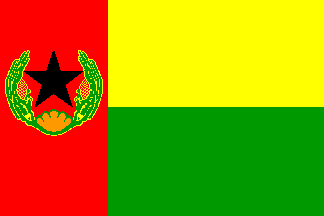 image by António Martins, 18 June 1997
image by António Martins, 18 June 1997
Last modified: 2022-05-14 by rob raeside
Keywords: star: 5 points (black) | paigc | scallop | wreath: maize |
Links: FOTW homepage |
search |
disclaimer and copyright |
write us |
mirrors
 image by António Martins, 18 June 1997
image by António Martins, 18 June 1997
See also:
Prior to 1992, the similarity between the two nations’ flags was explained by the fact that both were derived from the flag of the Partido Africano da Independência da Guiné e Cabo Verde (P.A.I.G.C.), the liberation movement which succeeded in gaining independence for both countries (Guinea-Bissau in 1974, Cape Verde in 1975). P.A.I.G.C.’s aim had been that the two nations should unite, but this merger was scotched in 1980 by a military coup in Guinea-Bissau.C. Veale, quoting [dev94]
This flag is very similar to
Guinea-Bissau’s, but 2:3 (instead of 1:2) and
with a maize wreath and a scallop shell around the black star. This
device is not centered, but positioned in such a manner that the lower
points of the star lye on the same line as the yellow-green boundary.
António Martins, 18 June 1997
Cape Verde Islands changed its flag for political reasons, but not
because of a political change of its own regime, rather because of a
political change in another nation. Upon initial independence both Cape
Verde Islands and Guinea-Bissau had similar flags
because they had shared a common liberation
movement. That movement became the leading political party in both.
When a coup replaced that party in Guinea-Bissau the leaders kept the old
flag, but Cape Verde Islands decided to change their own flag because they
felt the previous bond with Guinea-Bissau had been
broken.
Ned Smith, 27 January 2012
Below are two variants of the older national flag produced by the Annin flag company in the form of table flags. Noticeably the emblem is different on both, one is shifted higher than the other and the corn appears different on both designs, the first flag was made circa 1970s-1980s while the second one was made around the mid 1980s.